We meet the seven designers behind the V&A Museum of Childhood's specially commissioned dolls' house to coincide with their latest exhibition
There’s always been something satisfying about a dolls’ house. It was the miniature world where we once acted out the best dramas between our toys. It allowed us to pretend that we were grown-ups – or maybe even gods. We arranged the furniture just how we liked it, and cast the characters ourselves, and we didn’t care if the Playmobil mum in the living room was half the size of the plastic cat sitting next to her. It was about getting our faces up close, and imagining ourselves in there with them.
From 13 December, the V&A Museum of Childhood celebrates the world of the miniature with Small Stories – an exhibition of some of the UK’s best-loved dolls’ houses, from 19th century mansions to high-rise apartments. To mark the show, the museum has also commissioned the Dream House, a specially constructed installation with each room created by a different designer. The creators range from sculptors to print-makers, and the rooms go from the cosy to the surreal. Here, AnOther speaks to seven designers to find out how they built these tiny, fantasy worlds.
"I chose this design from a catalogue of Liberty Interior designs around the 1900s – I always wanted it to be a library, as I would love a library myself" – Emma Mawson
Library (A Recent Plan) by Liberty Art Fabrics Interiors
Emma Mawston, head of design: “I chose this design from a catalogue of Liberty Interior designs around the 1900s. I always wanted it to be a library, as I would love a library myself. The room was designed for someone with a creative mind – someone who loves a briefcase, so they can not only carry around work but also books to read, and who loves being surrounded by beautiful objects and prints. Although it was designed in the early 20th century, the interior wouldn’t be out of place today.
Our designer Keighley Shepherdly made the books in the studio and covered them with archive prints. The titles refer to books in print during that time, with a few exceptions of later titles that we love. We put The Invisible Man on the table, as a little joke because no one is in the room.
The rug and cushions were hand sewn by The Royal School of Needlework at Hampton Court, from Liberty archive images of the period. The miniature briefcase was made by bespoke bag and satchel maker Nneka at N’Damus. Joy Roberts of Moorcroft pottery supervised the making of miniature pots that are tiny replicas of vases made during this period. They have a long association with Liberty and still sell their ceramics in the store.”
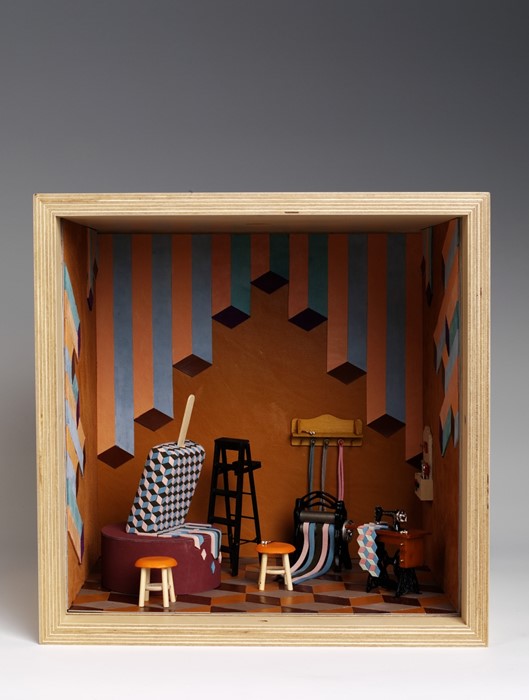
A Night In The Studio by Ina Hyun K Shin
“I spend a great amount of time in my studio every day. It’s kind of my second home now. So I thought maybe I could make a tiny little workroom, showing the materials I use and the projects I work on. Just a place where I could do my normal, ordinary job – cutting the leather pieces and combining them into geometric patterns. It’s an imaginative version of my studio, and it’s all leather, apart from the furniture, which I bought from a toy shop. I imagine a tiny little version of myself in there, working on an ice-lolly-shaped sculpture.”
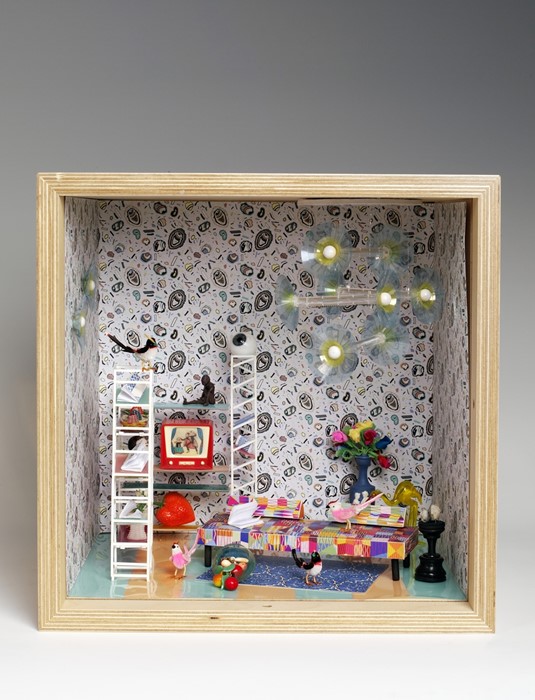
If a Budgie Dreamed of Being a Magpie by Bethan Wood
“I thought it would be fun to use some of the things that I have around me, so I went through my knick-knacks and started building up a room with them. I had quite a few scale models for my work, which fitted in well, including a model of the zigzag library, a project that I’d done previously. I changed the colours to echo Laurie Simmons’ Kaleidoscope House, as a little nod to that.
I mixed in things that I dream of having in my own future fantasy room. I’d love to do my own wallpaper, so I made some using one of my patterns. I made books using an invite I had for one of KTZ’s fashion shows, and I borrowed little models from Francis Upritchard. She makes beautiful tiny models of her sculptures when she’s designing the layouts for her exhibitions, and one day I’d love to own a piece by her.
I added in these small birds that I’d picked up in Spitalfields Market. I liked the idea of asking: if a canary could be a magpie, what kind of room would they build? It would be lots of colours and lots of objects. I tried to keep it fun and think about how any child would build up a space, with things that aren’t always in scale with each other, but seem to work together to create a mini world – little things, and then suddenly there’s a normal-sized glass eyeball.”
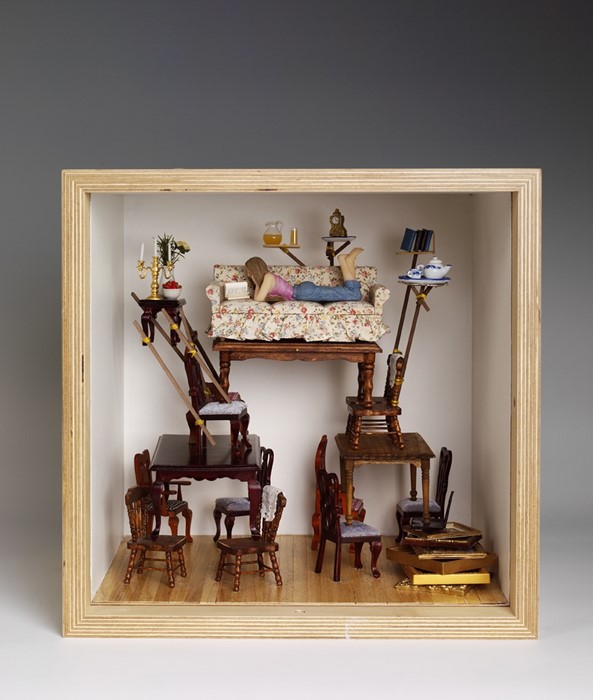
Offline Hideaway by Dominic Wilcox
“I was sent the empty box, and I immediately started looking for furniture. I came across this girl who was leaving for university, and her parents were selling off some dolls’ house furniture from her childhood. And I thought that was interesting. I created this room as a narrative piece about a person who is getting away from technology in order to read an ‘analogue’ book. At the bottom, you can see a laptop with a table on top of it.
It’s referencing my own work, in a way. I did a piece called Tree Branch Work Desk where I’m sitting up a tree with my cup of tea and a glass of pens. In the same way here, I’ve surrounded the girl with her various everyday items. You just imagine her parents coming into the room and seeing this construction.”
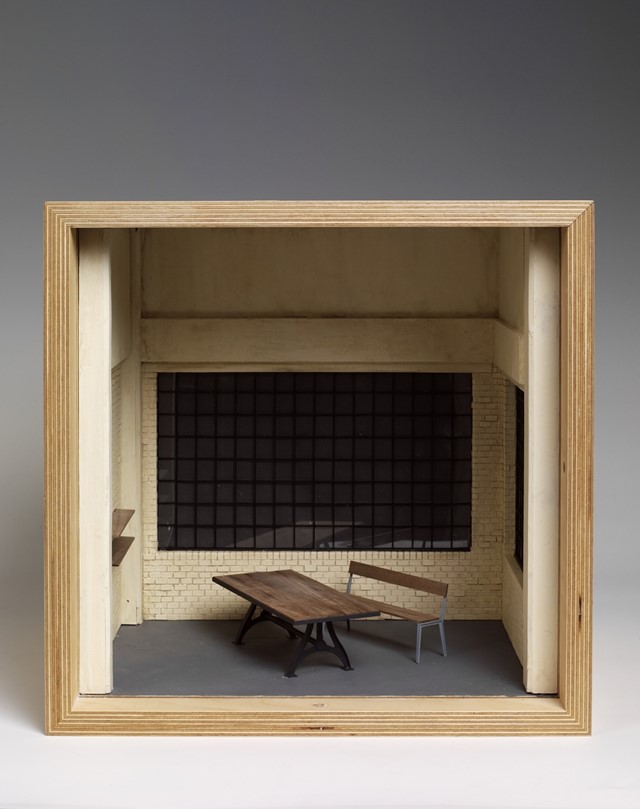
Bermondsey Studio by East London Furniture, Reuben Le Prevost and Jessica Sutton
Jessica Sutton, model maker: “Reuben’s company East London Furniture were approached to do this project. I’ve worked with him previously, so he got me involved as well. They’re getting kicked out of their Bermondsey workshop soon, as with a lot of warehouse spaces in London – I think it’s going to be developed. So we decided to recreate that and use it as a showroom for some of Reuben’s recent designs. We thought it would be a nice little homage to the East London Furniture workshop, to immortalise it in model form.
It’s a bit exaggerated – we made the ceilings higher, but the finish of the walls and the dirty old paint is very close to what it actually looks like in the workshop. The table is an East London Furniture design – I believe that one was made for the Twitter offices. But the bench and the shelving buckets are from Reuben’s new business venture, Goldkorn, inspired by utilitarian modernist furniture from the 1950s.
Making the bricks was really therapeutic. I printed a grid onto watercolour paper, because it’s got that nice rough texture, and cut out hundreds of bricks. Then I glued them all into place, one by one, with a pair of tweezers. The best way to get the finish of the dirty walls is to imitate what happens in real life, so I painted it all one flat colour and then I dripped dirty water down it. You let that dry, then rub it back, and it gives a really grimy feeling.”
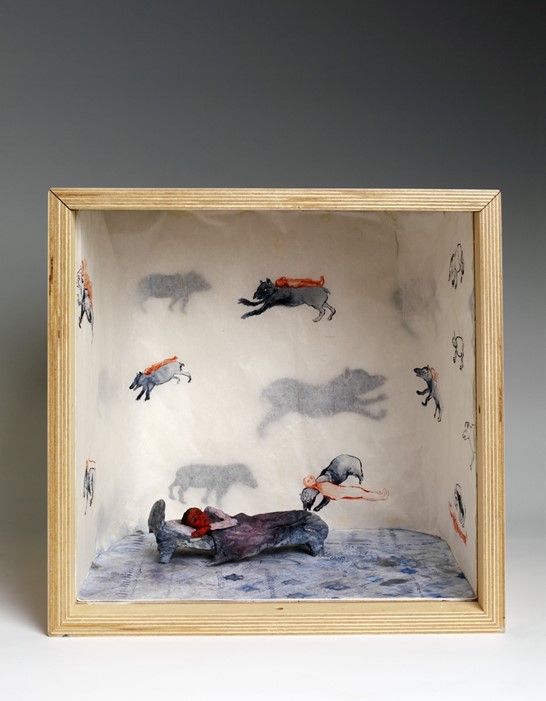
Wilderness Dreams by Orly Orbach
“Susan Stewart’s beautiful book On Longing was a big reference point for me. She writes about dolls’ houses as places that describe infinity – it’s a room within a room, which suggests that it could go on forever.
I felt a compulsion to bring in a wild element that would break up the silence and stillness of the dolls’ house, which was traditionally designed to be looked at, but not to be played with. For me it represents the parallel universe of domestic space, associated with class, taste and cultural norms that one must adhere to. These can be claustrophobic and oppressive, and my instinct was to work against it, and imagine stripping layers of wallpaper off the room until one reaches a real surface of a cave, a sort of original dwelling place and a place of dreams.
I wanted the animal on the walls to be ambiguous – it looks like it might devour the character, but in fact it lifts it up and carries it into a dream world. The main character could be any of us. It has an ethnicity you can’t quite pinpoint – it’s universal man.”
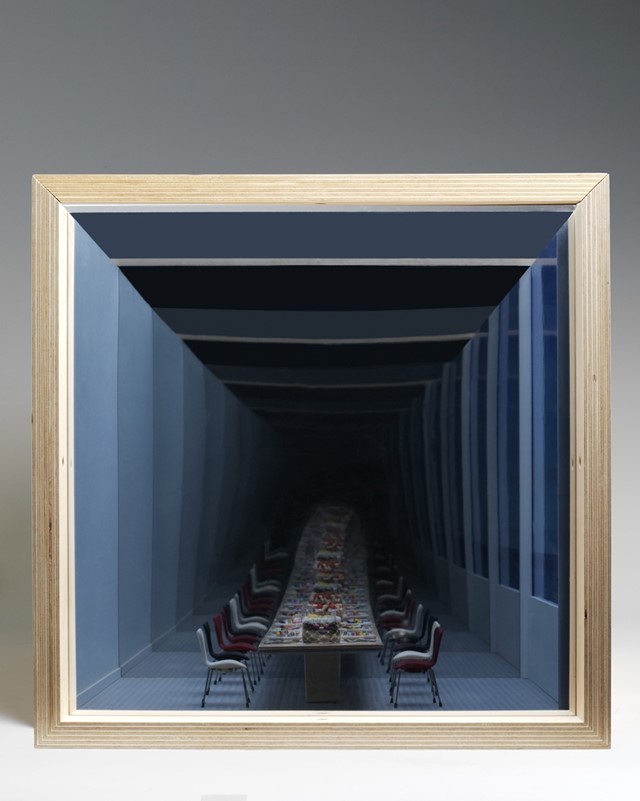
The Longest Party Table In The World by Paul Priestman, PriestmanGoode
“My company specialises in making small spaces feel as big as possible, and this interest can probably be traced back to the pin-hole viewers I used to make out of shoe boxes when I was growing up. When I was invited to create a Dream House room, that’s what I instantly thought of.
I wanted to create something that would appeal to children – make them think about how it works, and how the effect might be achieved. I used a two-way mirror to create the illusion of space. When you first see the box from the front, it looks like a mirror. As you get closer you realise there’s something more to discover inside.
I was also thinking of the longest party table in the world, which made me think of the Mad Hatter’s Tea Party in Alice in Wonderland. If you look on the right in the room, there’s a seascape on the wall, and the mirrors give the effect that the table is this endless table, overlooking the sea. I like the idea of this room as a place where great memories are created.”
Small Stories: At Home in a Dolls' House is at the V&A Museum of Childhood from December 13 - September 6, 2015
Words by Hattie Crisell
